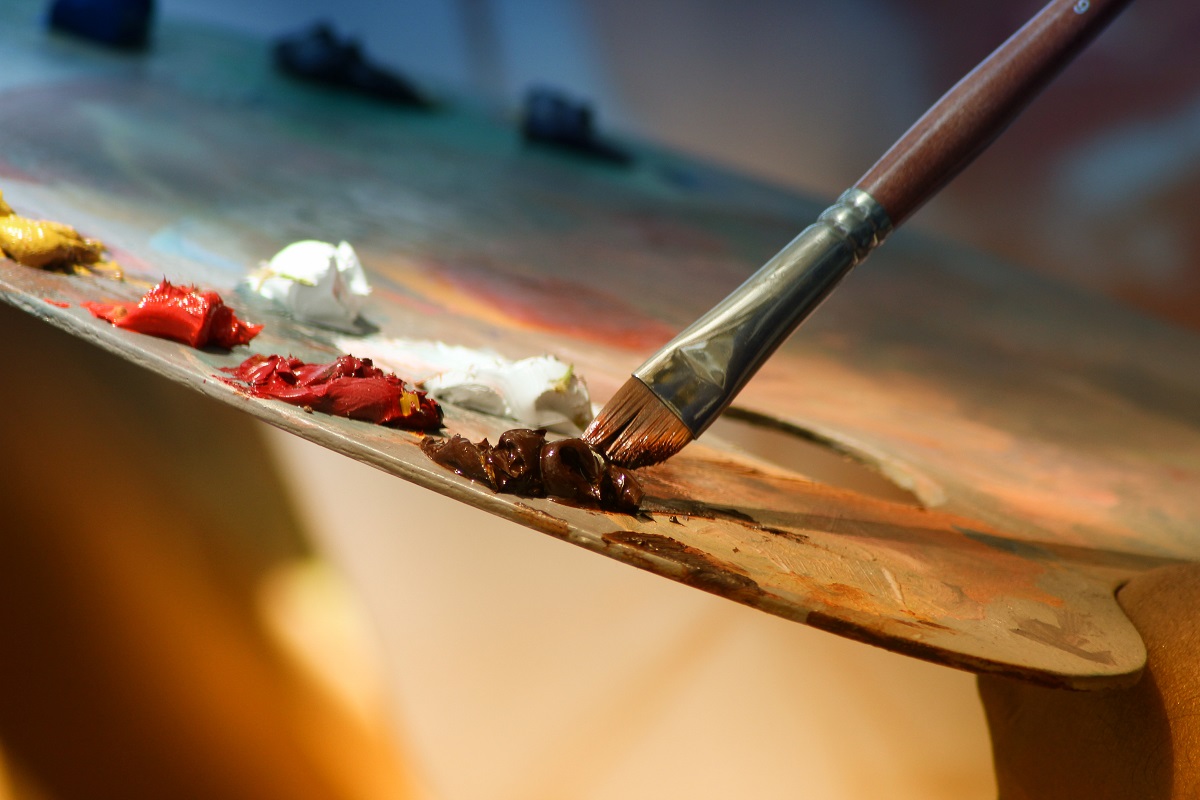In the age of modern art, there are no rules for what artists can and can’t use. While painting as an art form has existed as early as 32,000 years ago, using spray paint on canvas is a relatively new form of art painting.
While there are no rules for creating art, it’s important to know how to best prepare and handle spray paints and how to effectively use it to achieve your desired effect. Here’s an in-depth guide on spray paints and how to create your own artwork on canvas art.
History & Background of Spray Paint Art
Spray paint origins stem back to the 1890s. Joseph Binks, a decorations director for a retail business, created a hand pump that could easily spray white paint on the walls of the store. This is the first known prototype of the spray paint, except it did not use pressure and aerosol that all spray paints use today.
The spray paint device itself, however, would not be invented until 1949. The aerosol can was invented in 1927 by a Norwegian inventor named Erik Rotheim. In 1949, American Edward Seymour added aluminum paint to an aerosol can as a way to rapidly apply an even layer of paint.
While most people at the time only saw it as a novelty product that wouldn’t last in the long run, he would patent the spray paint can technology two years later. However, it proved to be more useful than most people imagined as the spray paint can became a useful tool for painters and contractors in the building and construction industry. Seymour would go on to find his own company focused on spray paint, which more businesses adapted. Some spray paint manufacturers would add a metal, marble, or glass ball (known as the pea) inside the can to help mix the paint when shaken.
How Spray Paints Work
Also known as aerosol paint, spray paints generally work because the pressurized can contains paint and a propellant that, when sprayed, creates a mist of paint that can evenly coat a surface without the need for a paintbrush or paint roller. Compared to the other two methods of paint application, spray paints is faster to use and (if used properly) cleaner and more uniform.
Spray paints in the market today are available in various finishes and designed for different types of surfaces. So, when painting on canvas, be sure to find spray paints appropriate for canvas. While spray paints are generally good for canvas surfaces, some may be too strong or too thin to achieve your desired effect.
Spray paint cans vary slightly depending on the manufacturer, but cans often have three main parts: the valve, the dip tube, and the pea. When spray paint is manufactured, cans are first filled with paint. It is sealed before a gas propellant is injected before the valve closes it, causing the can to be tightly compressed in the inside.
The way a spray can functions is due to pressure. When you press the nozzle of the can, you’re actually pressing the valve that keeps the can tightly pressured. The sudden change in pressure causes the propellant to expand, pushing the paint down and into the dip tube. The dip tube serves as a straw where the paint travels upwards to the valve. The paint then exits the nozzle in a fine and even mist.
Here’s where a bit of chemistry comes in. Some of the propellant in the can will push the paint down. However, there’s also a bit of propellant mixed in with the paint (hence the need to mix the can to let the pea mix the two). When released from the valve, the paint atomizes into tiny particles. Because propellants have positively charged each particle, these particles repel each other, which is why the mist causes an evenly and uniformly painted surface. And since surfaces are negatively charged, all of the paint particles will attach itself to the surface even in non-porous surfaces like metal.
Spray Paint on Canvas
Spray paints can work well on canvas. While it does help to prepare your canvas with a layer of gesso (a primer used to prepare surfaces like cardboard and canvases to achieve an ideal texture to help make the paint stick and retain its vibrant color, spray paints are generally a good wet medium that can work on canvas. However, some canvases can already be sold primed with acrylic gesso or oil-based primer.
When dealing with spray paints, however, it’s important to take note of the brands, finish, and the specialty. Brands can have different paint formulas, which means that one brand’s color tones won’t complement the tones of other brands’ spray paints. Spray paints can vary between matte, glossy, and many other finishes, so be careful you’re buying matching spray paint finishes or ones that you think will complement the final output.
While spray paints don’t require brushes or rollers, the same rules of paint application apply. However, keep in mind that the closer your nozzle is to the canvas, the smaller the reach of the paint and the faster a certain area will be spray painted. Canvas material is fairly absorbent, and too much paint in one area can cause the canvas to absorb too much paint, causing drops of spray paint to leak onto other parts of the canvas.
For inspiration, you’ll find plenty of artists online using spray paint on canvas. You can opt to do abstract spray paint, or you can create your own takes on landscapes, cityscapes, people, animals, and much more.
Spray Paint and Stencils
Because spray paint cans do not use paintbrushes, sponges, or rollers to control the direction of the paint, you might be wondering how some artists manage to make definitive shapes using spray paint. This is through the use of stencils or shapes placed on top of the canvas before applying spray paint so that, when the stencil is removed, you can see the shape on the canvas.
Stencils can range from simple shapes like circles and stars to more intricate shapes and details. While there are some stencils available online, some shapes and figures may require you to make one yourself. It’s very easy to make your own stencil (you’ll only need a few supplies you probably have around the house) as long as you know how to draw. If you can’t, you can try printing the image of the stencil you want to create and then tracing the outline.
Avoid using regular paper to make your stencil. Regular paper is good for a single-use stencil, but you may risk the spray paint leaking through the paper and onto your canvas, which cancels out the whole purpose of stenciling. Instead, use materials like cardboard, poster board, acetate, and other non-porous or thick materials.
In fact, you can even get creative with your stencils. Instead of making circle stencils with cardboard, you can opt to use recycled items like jar lids, bottle caps, plates, buttons, and CDs, depending on the size you want to create. As long as the object doesn’t risk leaking spray paint onto your artwork and gets the job done, you can turn it into a stencil.
Spray Paint Tips: Do’s and Don’ts

- Wear protective face gear. Spray paint contains a lot of gas propellant, which is released every time you press the valve. Without protective face gear like face masks to cover your nose and mouth and goggles to cover your eyes, prolonged exposure to spray paint fumes may cause eye, nose, and throat irritation, headaches, allergic skin reaction, and nausea.
- Work in a well-ventilated area. If you’re working indoors, be sure that your room has access to ventilation, exhaust systems, or plenty of windows. Otherwise, you’ll be enclosing yourself in a room filled with gas fumes.
- Avoid using near an open flame and hot surfaces. The spray paint’s propellant is extremely flammable, which means that if you spray at a spark or flame, it’s bound to catch fire. In fact, if you’re in an enclosed room filled with spray paint fumes and you light a cigarette, that cigarette may blow up due to the flammable air around it.
- Do not puncture the spray can. You might have seen videos like these that tell you that even when you think a can is empty, if you puncture them the right way, you’ll find there’s still a lot of paint that can be used. I do not recommend this. There’s a huge risk from puncturing a spray can incorrectly, which includes releasing a lot of propellant fumes and causing the can to explode. These risks are not worth getting a few more milliliters of paint. If it stops spraying paint, dispose of the can properly.
- Priming is key. For the best result, prime your canvas at least 24 hours with gesso before using it. You can also buy pre-primed canvas boards in art supply stores, but these may be more expensive than average canvases.
- The farther the can, the thinner the coat. The farther you place your spray paint can from your canvas, the more space the spray paint has to atomize and repel from each other. This is why the paint spreads out more and results in a thinner layer. If you want a smaller reach or increase how saturated the coat will be, move the can closer.
Spray paint on canvas is a modern take on traditional paintings. When done the right way, you can achieve a smooth and even effect that can result in an output that’s longer and more difficult to do with everyday paintbrushes. However, spray paint cans can be delicate to handle, so take precautions when using them.




